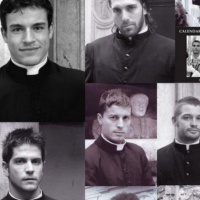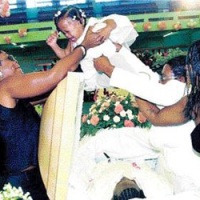NIKABRIK’S CANDIDATE
by Gina Dalfonzo
1 . 22 . 16
If you ever doubt that C. S. Lewis was gifted with a prophetic voice, you need look no further for correction than Prince Caspian.
In the story, you may remember, Narnia is in a desperate situation. The Telmarines have taken over, and the citizens of Narnia have been persecuted, silenced, and driven into hiding. When Prince Caspian—a Telmarine himself, but one who sympathizes with the Narnian cause—joins forces with them, this leads to a fresh round of attacks from the other Telmarines and their king, Miraz. The Narnians try to summon help by using Queen Susan’s horn—and they are successful, though not all of them realize it right away.
Drawn to Narnia by the call of the horn, Peter and Edmund and their guide, the dwarf Trumpkin, come upon a handful of Narnians meeting with Prince Caspian. Nikabrik, another dwarf, is angry that apparently no help has come from Aslan or the old kings and queens of Narnia. While others argue that “help will come” if they can wait patiently, Nikabrik contends that there is no time to wait: They are running out of food and reinforcements.
If Aslan won’t help, Nikabrik adds, perhaps another power will:
“The stories tell of other powers besides the ancient Kings and Queens. How if we could call them up?” . . .
“Who do you mean?” said Caspian at last.
“I mean a power so much greater than Aslan’s that it held Narnia spellbound for years and years, if the stories are true.”
“The White Witch!” cried three voices all at once. . . .
This, of course, is the same Witch who killed Aslan in The Lion, the Witch, and the Wardrobe. Nikabrik has already gone so far as to recruit a sorceress to raise the Witch from the dead. But the others are horrified—so horrified that a battle ensues, joined by the Pevensies and Trumpkin. By the time it’s over, Nikabrik and his allies are dead themselves.
How could one of the good guys in this story become corrupt enough to seek help from someone whose greed, brutality, and lust for power were legendary? As Lewis well knew, it can happen more easily and quickly than one might think. It’s been happening throughout history, ever since the first time the Israelites turned to a godless nation for help instead of trusting God to save them.
One can make a case that it’s happening right now within the conservative movement in the United States.
Which brings us back to the subject of prophetic voices. Did C. S. Lewis foresee the rise of Donald Trump? Not specifically, I’m sure. But Lewis had a remarkable understanding of human nature. He knew what it was like to feel that all hope was lost. And he knew that fear and despair can drive decent people to look for someone, anyone, who projects an appearance of strength.
Through the character of Nikabrik, Lewis explored the depths to which we can fall through fear. The first time Caspian meets Nikabrik, he is waking up after an accident and hears the dwarf’s voice near him, saying, “Kill it. . . . We can’t let it live. It would betray us.” There is absolutely no room in Nikabrik’s mind for the idea that a Telmarine could be good. And at first we can sympathize; his people have suffered greatly under the Telmarines, and he is fiercely loyal to his people—a good quality. But as Lewis frequently warned us, good qualities can be twisted and used for evil purposes.
Nikabrik’s fears are legitimate. His enemies are real and powerful and committed to the annihilation of his entire race. He is right to recognize the need for help. He is wrong to decide that help must come from a force equally merciless—wrong when he tells Caspian, “I’ll believe in anyone or anything . . . that’ll batter these cursed Telmarine barbarians to pieces or drive them out of Narnia. Anyone or anything, Aslan or the White Witch, do you understand?”
When his friend Trufflehunter reminds him that the Witch “was a worse enemy than Miraz and all his race,” Nikabrik’s retort is telling: “Not to Dwarfs, she wasn’t.” His own people and their safety are all that matter to him now. Instead of being an important priority, this has become his only priority—and any attempt to remind him that other considerations exist brings only his contempt and anger.
This is how good people with strong, ingrained values—people who have invested time and money in the sanctity of life, religious liberty, and similarly noble causes—can come to support a man who changes his convictions more often than his shirts. This is how people concerned about the dignity of the office of President end up flocking to a reality-show star who spends his days on Twitter calling people “dumb” and “loser.” This is how some who have professed faith in Jesus Christ are lured by a man who openly puts all his faith in power and money, the very things Christ warned us against prizing too highly. As one wag on Twitter pointed out, “If elected, Donald Trump will be the first US president to own a strip club,” and yet he has the support of Christians who fervently believe that this country needs to clean up its morals.
As Joseph Loconte has observed, the Narnia stories offer us “a view of the world that is both tragic and hopeful. The tragedy lies in the corruption caused by the desire for power, often disguised by appeals to religion and morals.” How dangerously easy it is for the desire for power to take on that disguise—and how easily we Christians fall for it.
Tired of waiting for Aslan—who may be nearer than we think—we turn elsewhere. It doesn’t matter if our candidate hates, bullies, and exploits other people, the reasoning goes, just as long as he’s good to us and gives us what we want. Hatred is a perfectly acceptable weapon, as long as it’s “on our side.”
So said Nikabrik as he prepared to unleash a great evil on the land of Narnia.
C. S. Lewis may have lived well before Donald Trump’s time, but he was prescient about the situation. The only fate that awaits a group that turns against its own core values for the sake of security and power is the fate of Nikabrik.
Gina Dalfonzo is editor of BreakPoint.org and Dickensblog.























